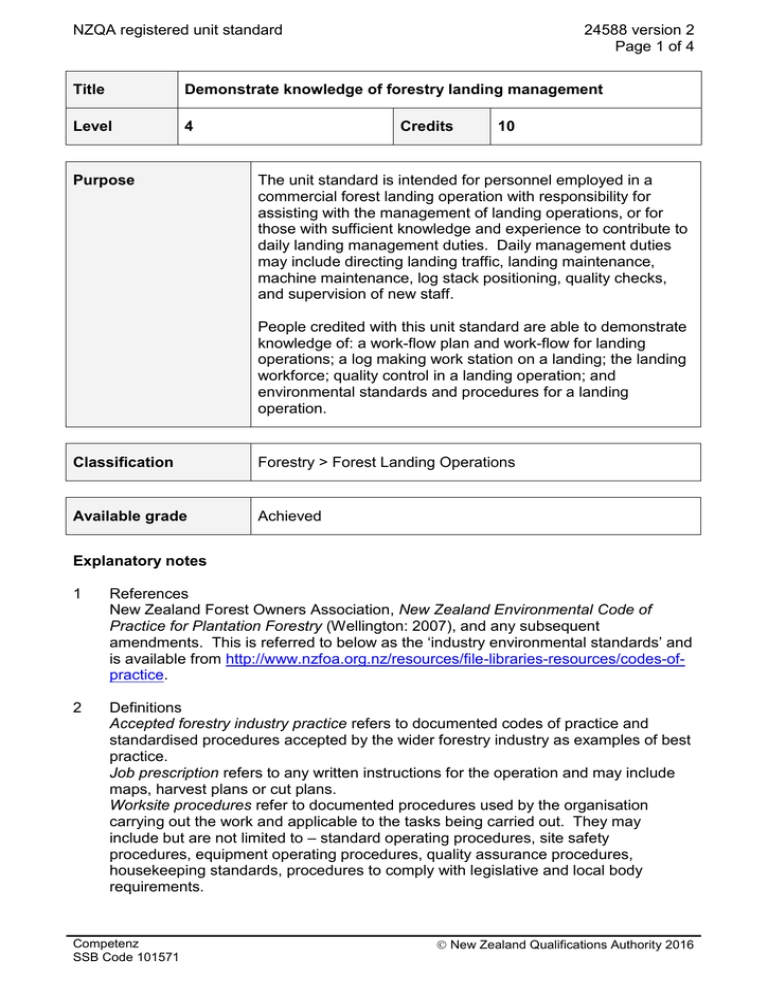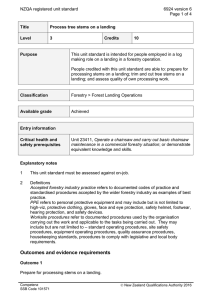NZQA registered unit standard 24588 version 2 Page 1 of 4
advertisement

NZQA registered unit standard 24588 version 2 Page 1 of 4 Title Demonstrate knowledge of forestry landing management Level 4 Purpose Credits 10 The unit standard is intended for personnel employed in a commercial forest landing operation with responsibility for assisting with the management of landing operations, or for those with sufficient knowledge and experience to contribute to daily landing management duties. Daily management duties may include directing landing traffic, landing maintenance, machine maintenance, log stack positioning, quality checks, and supervision of new staff. People credited with this unit standard are able to demonstrate knowledge of: a work-flow plan and work-flow for landing operations; a log making work station on a landing; the landing workforce; quality control in a landing operation; and environmental standards and procedures for a landing operation. Classification Forestry > Forest Landing Operations Available grade Achieved Explanatory notes 1 References New Zealand Forest Owners Association, New Zealand Environmental Code of Practice for Plantation Forestry (Wellington: 2007), and any subsequent amendments. This is referred to below as the ‘industry environmental standards’ and is available from http://www.nzfoa.org.nz/resources/file-libraries-resources/codes-ofpractice. 2 Definitions Accepted forestry industry practice refers to documented codes of practice and standardised procedures accepted by the wider forestry industry as examples of best practice. Job prescription refers to any written instructions for the operation and may include maps, harvest plans or cut plans. Worksite procedures refer to documented procedures used by the organisation carrying out the work and applicable to the tasks being carried out. They may include but are not limited to – standard operating procedures, site safety procedures, equipment operating procedures, quality assurance procedures, housekeeping standards, procedures to comply with legislative and local body requirements. Competenz SSB Code 101571 New Zealand Qualifications Authority 2016 NZQA registered unit standard 24588 version 2 Page 2 of 4 Outcomes and evidence requirements Outcome 1 Demonstrate knowledge of a work-flow plan and work-flow for landing operations. Evidence requirements 1.1 The purpose of a work-flow plan for landing operations is described in accordance with the accepted forestry industry practice. 1.2 Resources that need to be considered when developing a work-flow plan are described in terms of their impact on work-flow on a landing. 1.3 Factors that may affect the positioning of a log chute entry to the landing are described in accordance with the accepted forestry industry practice. 1.4 Factors affecting the positioning of log stacks and load out requirements on a landing are described in accordance with the accepted forestry industry practice. 1.5 Requirements of a safe working zone for log processing are described in accordance with the accepted forestry industry practice and worksite procedures. 1.6 Factors affecting the location of parking areas, rest and refreshment facilities, and areas for refuelling and servicing machinery are described in accordance with the accepted forestry industry practice and worksite procedures. 1.7 A specific landing site is examined and the best positions for resources and work areas are identified in accordance with the accepted forestry industry practice. Range log chute entry, log stacks, log processing area, parking area, rest and refreshment areas, refuelling areas, servicing areas. Outcome 2 Demonstrate knowledge of a log making work station on a landing. Evidence requirements 2.1 Requirements for setting out cross-cutting bed runners are described in accordance with the accepted forestry industry practice. 2.2 Hazards present on a landing are identified, and a method of managing each hazard is stated, in accordance with the accepted forestry industry practice. Outcome 3 Demonstrate knowledge of the landing workforce. Competenz SSB Code 101571 New Zealand Qualifications Authority 2016 NZQA registered unit standard 24588 version 2 Page 3 of 4 Evidence requirements 3.1 Activities that take place on the landing are described in terms of the skill requirements of the person undertaking the activity. 3.2 Landing workforce training and supervisory requirements are described in accordance with the accepted forestry industry practice and worksite procedures. 3.3 Communication requirements for a landing are described in accordance with the accepted forestry industry practice and worksite procedures. Outcome 4 Demonstrate knowledge of quality control in a landing operation. Evidence requirements 4.1 The importance of calibrating log-measuring equipment is explained in accordance with the accepted forestry industry practice. 4.2 Branding and stacking requirements for an operation are described in accordance with worksite procedures. 4.3 The purpose of continuously checking against log specifications is described in terms of customer requirements and worksite procedures. 4.4 Procedures for dealing with out-of-specification logs are described in accordance with worksite procedures. Outcome 5 Demonstrate knowledge of environmental standards and procedures for a landing operation. Evidence requirements 5.1 Environmental requirements for a landing operation are explained in accordance with the industry environmental standards and the job prescription. Range waste oil, discarded ropes, replaced machine parts, logging debris, water management, off cuts, rejects. 5.2 Procedures for dealing with spills, leaks, or fire involving a hazardous substance are explained in accordance with the industry environmental standards. 5.3 Agencies with legal jurisdiction that may require notification in the event of an environmental incident are identified in accordance with the industry environmental standards. Competenz SSB Code 101571 New Zealand Qualifications Authority 2016 NZQA registered unit standard Planned review date 24588 version 2 Page 4 of 4 31 December 2020 Status information and last date for assessment for superseded versions Process Version Date Last Date for Assessment Registration 1 22 May 2008 31 December 2016 Review 2 19 March 2015 N/A Consent and Moderation Requirements (CMR) reference 0173 This CMR can be accessed at http://www.nzqa.govt.nz/framework/search/index.do. Please note Providers must be granted consent to assess against standards (accredited) by NZQA, before they can report credits from assessment against unit standards or deliver courses of study leading to that assessment. Industry Training Organisations must be granted consent to assess against standards by NZQA before they can register credits from assessment against unit standards. Providers and Industry Training Organisations, which have been granted consent and which are assessing against unit standards must engage with the moderation system that applies to those standards. Requirements for consent to assess and an outline of the moderation system that applies to this standard are outlined in the Consent and Moderation Requirements (CMR). The CMR also includes useful information about special requirements for organisations wishing to develop education and training programmes, such as minimum qualifications for tutors and assessors, and special resource requirements. Comments on this unit standard Please contact Competenz qualifications@competenz.org.nz if you wish to suggest changes to the content of this unit standard. Competenz SSB Code 101571 New Zealand Qualifications Authority 2016


